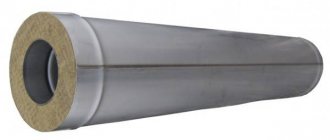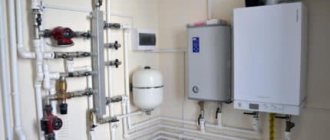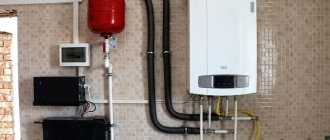Gas cheap, therefore it is a popular type of fuel for heating. People want to install gas boilers in their apartments so that heating and hot water are available all year round.
But when installing a heating device, there are some difficulties associated with the room’s compliance with fire safety standards and the collection of various documents.
And installation is carried out only by those organizations that have certificates for such activities and qualified specialists.
Rules for installing a gas boiler in an apartment building
To install, you must follow some rules, know the features, and have at least basic experience working with such equipment.
The gas boiler comes in wall-mounted and floor-mounted versions. For apartments, wall-mounted devices are most often chosen.
By design: single-circuit (heating), double-circuit (heating + hot water) . The units are also available as naturally aspirated and turbocharged.
Combustion chambers are classified as open or closed . In the first case, combustion products and smoke come out on their own, in the second - with the help of a fan.
If the wall is made of flammable material, then the installation site must be pre-insulated. The unit itself should not fit tightly to the wall; it should be moved at least 2 cm away from it.
If the connection is made to an old chimney, then you need to clean it in advance . The boiler is connected to the chimney only by a metal pipe. It can withstand high temperatures and mechanical stress. Interacts less with condensate and combustion products.
The vertical section of the connection from the boiler to the bend must be at least 2 times the diameter of the connection . The pipe is made with a slope from the bend onwards.
Required documents
There is no exact list of required documentation. Somewhere they may require additional information. But basically it's:
- Conclusion, which indicates the possibility of disconnecting the apartment from central heating.
- Technical conditions for connection to gas supply. An application is submitted to the gas service indicating the expected volume of gas use.
- Installation project. It shows diagrams of how the boiler and gas pipeline will be installed. Only design engineers with a license for this type of activity have the right to prepare such a project. Then the project is approved by Gorgaz or another similar service.
- Documents for the gas heater (technical passport, operating manual, certificates, examination data that the device meets all criteria).
Unified rules for installing gas boilers in homes
gas boiler room
To ensure trouble-free and safe operation of gas heating equipment, it is necessary to follow a number of strict, but fairly simple to follow rules.
Requirements for the premises under the boiler room
First of all, remember that natural gas is an extremely flammable substance and its use in unprepared and inappropriate premises can lead to very unpleasant consequences.
However, gas heating boilers with a power of up to 60 kilowatts can be installed in any, even unprepared, premises. But the boilers must be single-circuit. If the heating boiler has a second circuit, its installation in a kitchen area is prohibited.
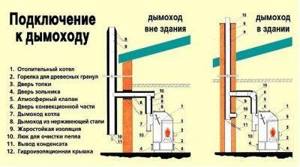
chimney connection
However, it is not recommended to install gas equipment in residential areas. It is advisable to allocate a separate room for the boiler room in a private house and ensure that it has a window in the outer wall of the building.
To install gas heating boilers with a power of up to 150 kilowatts, you can choose any floor of your home. However, if you plan to install a more powerful heating system, then it can only be placed in the basement or basement.
Please note that according to existing standards, per 1 kilowatt of gas boiler power there should be 0.2 cubic meters of the volume of the room in which it is installed. Also, the gas boiler room in a private house must have a ceiling height of at least 2.5 meters and provide convenient access to any element of the heating system. The walls of a gas boiler room must be fire resistant with a rating of at least ¾ hour. Just like with other placement options, a separate gas boiler room must have natural light, that is, it must have a window in the outer wall of the house.
Requirements for chimneys of gas boilers
Chimneys of gas boilers of heating systems also have their own installation rules. Their incorrect operation can lead to the accumulation of combustion products and tragic consequences.
The required minimum chimney diameter is indicated in the specification for your gas boiler. In this case, its inlet cross-section must coincide with the cross-section of the outlet of the gas boiler.
To ensure the removal of combustion products, the upper edge of the chimney must be placed at least half a meter from the roof ridge. As a rule, round chimneys are used for gas heating, the walls of which are made of ferrous metal or stainless steel.
When creating a heating system project, it is necessary to ensure that the chimney of a gas boiler has no more than three bends or turns. The initial section of the chimney directly adjacent to the gas boiler must be at least 25 centimeters.
Obtaining permits
Due to the fact that gas heating is a source of increased danger, it is necessary to obtain a number of permits before installing it.
At the initial stage, you need to secure the connection to the gas supply pipe with an agreement. Before the construction of the heating system, a gasification project is developed and approved. Only after the project has been approved by an authorized organization can you begin purchasing equipment and directly installing it.
Rules for installing a wall-mounted gas boiler
After approval of the project, at the purchase stage, be sure to check the availability of fastening devices in the delivery kit. If the manufacturer does not include them in the kit, they must be purchased separately. Be sure to request a certificate for the gas boiler you purchase. Check the boiler markings and the information specified in the safety certificate.
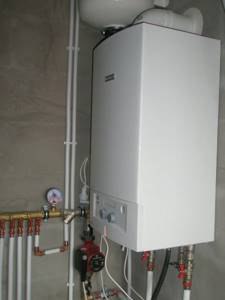
wall-mounted gas boiler
At the preliminary installation stage, thoroughly bleed the internal piping system of the boiler. Remove all transport plugs. The pipes are cleaned with a low-pressure water stream; the water will remove small debris and dust.
Make sure that the wall material on which you plan to place the gas boiler is made of non-combustible material. Otherwise, it must be reinforced with a fireproof coating more than 3 mm thick. With this placement, the boiler itself must be placed no less than 45 mm from the wall surface.
The installation height of a gas boiler is 80 to 160 cm. There should be no other electrical or gas equipment or any flammable materials at a distance of at least 20 cm from it.
When installing the mounting brackets, check their horizontal and vertical positions with a building level.
In the event that the design of a gas boiler requires draft in the chimney, we form and check the exit routes for combustion products. There are also so-called “non-chimney” boilers, in which combustion products are removed by forced air circulation through an exhaust fan.
Gas connection to the boiler is carried out with the mandatory participation of a certified specialist. During installation, only metal pipes and special connecting devices are used.
If your gas boiler has electrical appliances, we connect it to the electrical network through a separate circuit breaker protecting against short circuits and overheating.
The first start-up of a gas heating boiler must be carried out in the presence of a specialist from the gas company, after carefully checking that all installation rules have been followed.
Rules for installing a floor-standing gas boiler
Floor-standing gas boilers have greater power compared to wall-mounted ones and require stricter installation rules.
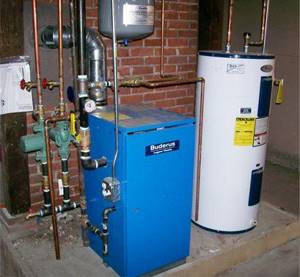
boiler room with floor boiler
When installing a floor-standing boiler, as a rule, a branched heating system is also installed, distributing heat to several rooms or several floors. Therefore, even before purchasing a boiler, it is necessary to draw up a design for the heating system and understand the location of all its elements, including the correspondence of the location of the outlet pipes of the floor-standing boiler to the inlet pipes of the heating system.
A floor-standing boiler can also be installed on a solid wooden floor, however (unlike a concrete floor) it must be protected with galvanized iron or clinker tiles. In this case, the non-combustible base must extend beyond the front side of the boiler by at least half a meter.
Like the wall-mounted option, floor-standing gas boilers are carefully checked according to the building level during installation. When installing such boilers, a high-quality chimney system must be equipped
Water heating systems based on gas boilers require the installation of a hardness filter for the incoming water flow.
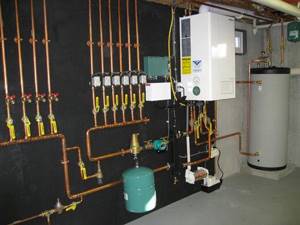
gas heating system
Please note that each water supply and intake pipe must be equipped with devices that facilitate their dismantling. This is done in order to replace any of the system elements in case of repair. Valves are also installed on all pipes.
The rules for installing a floor-standing gas boiler also require its connection and first start-up only with the participation of a specialist from the gas company.
Selecting a gas boiler and equipment for it
A double-circuit wall-mounted unit is often chosen because a single-circuit unit cannot meet all needs, while a floor-mounted unit has too much power and is more suitable for a private home.
When choosing, several criteria are taken into account:
- power;
- type of device (floor-standing or wall-mounted);
- burner type (open or closed);
- number of circuits;
- dependence on electricity;
- additional equipment (adjustments, display, security systems);
- manufacturer and price.
Installation
The device is unpacked and the integrity of the kit is checked according to the list supplied with the equipment. also inspect the appearance and check the technical specifications.
Actions:
- fire-resistant material to the wall at the location of the unit .
- Prepare for installation. Using water pressure, clear the inlet pipes of debris.
- Install a filter for cleaning the liquid , shut-off devices before and after the filter on the water supply pipe to the boiler.
- Install a chimney . Its diameter should not be less than that specified in the instructions. The cross-section is the same as the chimney opening of the boiler. The chimney must rise above the roof more than 0.5 m . It is good that it is made of steel and cylindrical in shape.
Photo 1. Installation of a gas boiler in an apartment. The device is installed under the ceiling, with a chimney mounted on top.
- Check traction . When the draft decreases, the automation should work and interrupt the operation of the boiler.
- Make a connection to the gas pipeline. This work is performed by qualified craftsmen from Gorgaz.
- Connect the boiler to an automatic overload protection device and connect it to the electrical network.
Important! The slope of the chimney should not be small so that condensate drains and cannot get back into the heating device.
Connection
Before connecting, the entire heating system must be thoroughly flushed with water pressure or using other special means designed for this purpose. This is done to prevent dirt and debris from getting into the boiler or pump, which could cause damage.
It doesn’t matter what material the heating system pipes are made of, but metal pipes must be connected to the supply and return apparatus. If the boiler is double-circuit, then a pressure reducer is installed.
Private heat
Should a citizen pay for a service that is not actually provided to him? Valentina Shesterikova from the Stavropol Territory posed this question to the judges of the Constitutional Court. The house in the city of Mikhailovsk with more than 80 apartments where she lives is connected to central heating, but two-thirds of the residents have not used it since 2015.
— Our house was not heated. The walls froze and became covered with frost in winter; in summer, due to dampness, they became covered with mold. The plaster was crumbling, and heat did not reach some apartments,” she said in the complaint. — Kommunkhoz brought the house to destruction. The administration, knowing our problem, allowed the entire house to switch to individual heating.
Now almost every apartment has gas boilers installed, the rooms have become warm and cozy, and residents can only rejoice - expenses have become significantly lower. For example, in February 2020, for the use of heat, hot water, and a gas stove in a one-room apartment, you had to pay only 410 rubles. And apartments whose owners did not install ISO now have normal centralized heating.
The residents of the rescued building were happy until in 2018, in accordance with the Rules for the provision of utility services to owners and users of premises in apartment buildings, they began to be charged amounts for heating common areas, dividing the readings of common building metering devices among absolutely all owners. And in the same February last year, the pensioner was charged 262 rubles, which is 60 percent of the payment for heating the entire apartment. If it seems to you that the amount is not so large, then you need to take into account that the pension of Valentina Shesterikova’s 63-year-old son does not reach 10 thousand rubles.
Now the Shpakovsky branch of Kraiteploenergo is suing the apartment owners, and they, in turn, sought protection in the highest legal authority of the country. “The house does not have a heating system in the common areas,” they explain. “Owners heat common areas using heat transfer from the walls of their apartments.”
The Constitutional Court clearly sided with the citizens. Of course, everyone is required to bear the costs of maintaining common property, including heating. If ISO is installed in the apartment, the owner only pays for heating of common areas. However, if there are no elements of the thermal system in the staircases and entrances, “indirect” heat comes through the general structures of the house - walls, floor slabs, that is, residents participate in the heating of the MOP. However, the existing rules and the formulas given in them do not take this possibility into account. The Constitutional Court recognized this state of affairs as inconsistent with the constitutional principle of equality before the law and the court, and also violating the right to private property.
The Constitutional Court recognized the state of affairs as inconsistent with the principle of equality before the law and the court
The Government of the Russian Federation has been instructed to make changes to the current procedure for calculating payments for utility services for heating in an apartment building so that they can take into account situations similar to the case in Mikhailovsk. However, until the rules change, the formulas will remain the same. As the Constitutional Court of the Russian Federation explains, this decision was dictated by “constitutional provisions on the economic and social solidarity of citizens (Article 75.1 of the Constitution of the Russian Federation),” since otherwise, in the absence of special calculation rules, otherwise could lead to a significant increase in heating payments for owners and users of other premises .
— Since a review of the applicant’s specific case may lead, among other things, to non-payment of the portion of heat actually supplied to this house via centralized heat energy networks and thereby to an imbalance in legal relations regarding the heat supply of the said house, the Constitutional Court of the Russian Federation considers it necessary to establish that the case of Valentina Shesterikova is not subject to revision, — the court indicated.
After the changes are developed and come into force, the pensioner can count on compensation, however, for this, a court of general jurisdiction, taking into account the new legal regulation, must establish “what amount of payments paid is, based on this resolution, excessive.” It is impossible to predict how long a new judicial round will take, but Valentina Nikolaevna is already 83 years old.
Signs of malfunction of the heating device in the apartment
In gas boilers, as in any equipment, malfunctions and malfunctions occur. Disconnection and inspection is required when:
- presence of soot ;
- flame separation;
- constant blackouts.
Many breakdowns require calling a qualified technician . But if the reason is traction and soot, then this can be eliminated yourself.
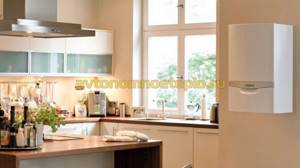
Is it possible to install a gas boiler in an apartment building?
Before installing a heat generator, you will need to terminate the contract with the company supplying heat to the house. Unilaterally, termination of the act is carried out through the court. Disconnection from the central heating system means a simultaneous cessation of hot water supply.
When installing an individual heating system, double-circuit gas heating boilers for an apartment are optimal. Boiler equipment is of a double-circuit type, simultaneously working to heat the coolant and provide hot water.
Installation in an apartment with central heating
Laws regulating the possibility of installing gas heating equipment in an apartment with central heating are specified in Federal Law No. 190 dated August 27, 20010. Additional instructions and requirements are given in RF PP dated February 13, 2006 N 83 “Rules for determining and providing technical connection conditions capital construction project to engineering and technical support networks.”
To connect autonomous heating, you need to contact the Gaznadzor organization to obtain technical conditions for reconstruction. Specifications are the actual permission to commission gas equipment. After this, the procedure for terminating the contract for central heating takes place.
Is it possible to use bottled gas?

A gas boiler in an apartment for heating and water supply in multi-storey buildings can only be connected to the central gas pipeline. Gas cylinder installations are allowed to be used in the following cases:
- The building is no higher than two floors in height.
- There is no more than 1 gas cylinder in one room at a time.
- The distance from the gas stove is at least 0.5 m, heating appliances are at least 1 m. It is optimal to use a screen between the gas cylinder installation and the heating surface of the household heating appliance.
- Only ventilated rooms are used as a boiler room. Connection to the boiler is made with a metal corrugated hose.
Based on the above standards, the use of liquefied gas cylinders, although allowed in low-rise apartment buildings, is inappropriate.
The procedure for installing a gas boiler in an apartment
The gas boiler is installed by a special installation organization that has permits for the right to carry out the relevant work. Work is carried out exclusively according to the approved project.
After the project is approved by regulatory authorities, the appropriate equipment is selected according to the specifications. Before installing the gas boiler, the completeness and serviceability of the purchased goods are checked.
Algorithm for performing installation work in an apartment with central heating in a multi-storey building:
- Install a protective fire-resistant coating on the wall of the unit.
- An anchor fastening is placed under the horizontal level; it usually comes complete with the boiler.
- Hang the unit on the mount and check the horizontal level.
- The boiler is connected to in-house engineering systems: water, heating pipes and electrical networks.
- Connecting the boiler on the gas side with the installation of a commercial gas meter is carried out by a representative of Gorgaz.
- Connecting the power supply and installing a protective grounding system from the gas boiler is carried out by electrical personnel.
- Connect to electricity and check the functionality of the grounding system.
- The first start-up after checking compliance with the rules for installing a gas boiler is carried out by a representative of Gorgaz.
- An act of putting the boiler into operation is drawn up with representatives of the customer, the design and installation organization, as well as the fire inspectorate, the architecture department and the SES.
How to choose a double-circuit gas boiler for an apartment
Floor heat generators often have excess power, therefore, their installation is not economically justified. For all these reasons, a wall-mounted double-circuit gas boiler for an apartment is the optimal and expedient solution.
When choosing a boiler, pay attention to several operating parameters:
- Burner type.
- Power.
- Manufacturer's brand.
Additionally, pay attention to the presence of modifications to the internal structure and controls. Double-circuit wall-mounted gas boilers for heating and hot water supply of apartments, the latest generation, have weather-dependent control. To level out peak DHW loads, a built-in storage boiler is installed inside the housing. Modulating burners smoothly change output depending on the heat needs of the room.
Which boiler is better for an apartment - with a closed or open burner?
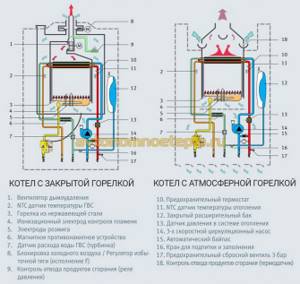
For an apartment, a boiler with a closed combustion chamber is better. Condensing boilers, in addition to the heat obtained by burning gas, additionally accumulate thermal energy obtained from targeted condensation. Efficiency varies between 98-109%. Turbocharged boilers are also economical and have high efficiency of up to 96%.
How to calculate the power of an apartment boiler
To convert the standard centralized heating of an apartment to heating from a gas boiler, you will need to correctly calculate the power of the heater. Lack of performance will lead to the need for constant operation of the boiler at maximum load. Excessive power will cause excessive gas consumption.
The minimum required boiler power for hot water and heating is calculated as follows:
- The total volume of the heated area is determined. Technical information about the apartment is in the house register or apartment passport. You can calculate the area yourself by multiplying the length by the width of each room, including corridors and hallways, and then adding up all the results obtained.
- Calculation of heated area - for apartments with a ceiling height of 2.7 m, the formula 1 kW = 10 m² is suitable. For a standard two-room apartment of 50 m², according to calculations, a 5 kW heat generator will be required.
- The power reserve is calculated - for an apartment it will be enough to choose a boiler with higher productivity: 10-15% for single-circuit options, 25-30% for double-circuit ones.
Requirements for installing a gas heating boiler in an apartment
In many regions of Russia, installing a gas boiler in an apartment and abandoning central heating in an apartment building is a problematic and painstaking process. To register, you will need specific knowledge and understanding of current laws. Unauthorized installation will result in a serious fine, which will cause a significant blow to the family budget.
Installation standards are described in detail in the Russian Federation Regulations dated February 13, 2006 N 83. Before you start processing documents, you should study the step-by-step plan for obtaining technical conditions and completing approvals. So, you can reduce the cost of money and time by about a third.
What documents are needed for installation

The installation procedure and rules do not change and require strict adherence.
Installation room requirements

Chimney for a gas boiler in an apartment building
Installation of gas heaters is allowed only if there is an appropriate smoke removal and ventilation system in the apartment. It is for this reason that installing a boiler with a closed combustion chamber connected to a horizontal chimney is the optimal solution. In some regions, there is no ban on the use of individual coaxial chimneys, which further simplifies the installation issue.
If a massive transition to autonomous heating is planned in an apartment building, the chimneys from the boilers are combined. A vertical coaxial pipe is installed to which all heating devices are connected.
To ensure the operability of the boiler in the boiler room, supply and exhaust devices are installed with a throughput capacity of at least three times the air exchange of the room per hour. Supply ventilation must be separate, not connected to other ventilation ducts in the bathroom and toilet.
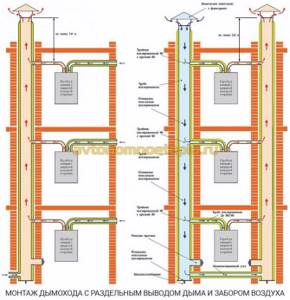
Individual gas boiler - pros and cons
Installing a double-circuit gas boiler in an apartment in an apartment building, when switching to autonomous heating, will require material costs, time and emotional strength. The process of abandoning central heating is described in detail on paper.
As practice shows, representatives of the heating network are extremely reluctant to issue permission to refuse heat supply and install their own heating system. Unwillingness to cooperate and all sorts of obstacles from regulatory authorities are the main disadvantage of an individual gas boiler.
There are a few more negative points:
- Unsuitability of apartments for installation of autonomous gas heating. You will have to go through several stages of approvals and financial investments will be required.
- The gas boiler must be grounded. As a grounding loop, you cannot use water supply risers or a neutral in the electrical network.
All the disadvantages mainly come down to the difficulty of obtaining permits and approvals, as well as performing installation work and connections. Heating costs when installing a gas boiler are reduced by almost half. The costs of re-issuing documents pay off already in the third heating season. At the same time, the consumer receives high-quality heat. Installing autonomous heating is completely justified and cost-effective.
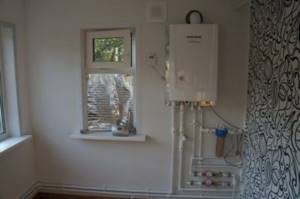
When installing gas boilers, it is important to adhere to the standards that are prescribed in SNiP-II-35-76 “Boiler installations” and the set of rules for the design of autonomous heat supply systems SP-41-104-2000. Otherwise, if they are not followed, the inspection authorities will not give permission to operate gas equipment. Let's consider what standards exist for installing a gas boiler.
Rules for installing gas equipment in an apartment
All the steps described above take place in both Russia and Ukraine. The difference can only be in the names of organizations and the cost of a particular service. Those who move into a new house that is not connected to central heating will have less fuss. There is no need to visit the heating network and disconnect from the risers, and permission to install a gas boiler in the apartment may be included in the package of documents. Everything else is unchanged.
However, there are still a few rules. First, once you receive the documents, you cannot install a gas boiler yourself: this should only be done by specially trained people. In some cases, these may not be employees of the organization supplying gas, but representatives of an installation service licensed for this type of work. Then, upon completion of installation, an engineer from the district or city gas supply organization will check the correctness of the connection and issue a permit to use gas. Only after this can the gas valve leading into the apartment be connected.
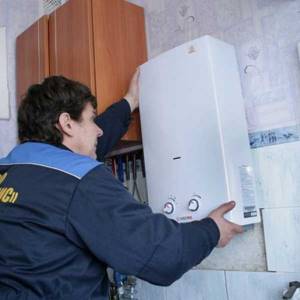
Installation of gas equipment must be carried out by employees of organizations licensed for this type of work.
The individual heating system must be checked before start-up. To do this, it starts at a pressure of at least 1.8 atm (you can control it on the boiler pressure gauge). If you hide the tubes in the walls or floor, it is advisable to apply more pressure and circulate the coolant through the pipes for at least a day. This will ensure that there are no leaks and that the connections are secure.
Before starting, it is necessary to bleed air from the equipment. Since the systems in apartments are made closed, you will have to use Mayevsky taps located on the radiators. The air in each radiator is vented, going around them several times until there is no air left at all. After this, the system can be started: switched on to heating mode.
Do not forget that modern boilers are controlled by automation, and it is demanding on voltage. Therefore, it is advisable to install a voltage stabilizer and an inverter (or an uninterruptible power supply). To protect the insides of the boiler from foreign impurities, filters must be installed at the gas and cold water inlets. The electrical outlet (and other gas appliance) must be located at least 30 cm from the boiler.
General requirements for installing a gas unit
The first standard that needs to be taken into account when choosing a gas boiler is whether the power of the device matches the area of the heated room. Optimal performance is calculated using special formulas.
There are models of gas boilers with different characteristics: floor-mounted, wall-mounted, with open or closed combustion chambers.
To install units with an open firebox (atmospheric), a full-fledged chimney is required, so such models are mainly used for heating private houses. Boilers with an open chamber may only be installed in a separate, specially equipped room - a boiler room or furnace room.
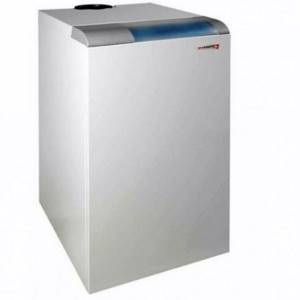
A gas device with a closed firebox (turbocharged) only needs to connect a coaxial chimney to exhaust smoke. It consists of two pipes and simultaneously ensures the removal of smoke and the flow of air masses to the burner device. Such a unit can be installed in any non-residential premises, for example, a kitchen, hallway or bathroom. The main thing is that it meets all the requirements of SNiP. However, if your device with a closed combustion chamber has a power of more than 60 kW, then you will also have to look for a separate room for it - a boiler room.
Premises requirements
The room allocated for installing a boiler in an apartment in an apartment building must meet fire safety and sanitary requirements.
Installation of gas boilers is permitted in non-residential premises of the permissible volume of a room with a door and window.
The wall for placing the boiler must be solid or additionally reinforced so that it can withstand the structure of the unit.
All surfaces adjacent to the boiler must be insulated with heat-resistant material, including the floor and ceiling. The front of the boiler must have a free space of at least 100 cm for its maintenance and repair.
Main characteristics of non-residential premises for installing a boiler in accordance with SNiP 42-01 and MDS 41.2-2000:
- minimum ceiling height - 2.5 m;
- window area at the rate of 0.03 m2 per 1 m3 of room volume;
- the design of the room elements must correspond to a fire resistance of at least REI 45;
- the door in the room must have a width of 80 cm and a bottom gap of 2 cm;
- the room must have supply and exhaust ventilation with 3 air changes per hour according to the volume of the room, plus additional volume for burning gas fuel in the boiler.
Best place to install
The most suitable room is the kitchen, especially since it already has a gas inlet. The minimum furnace area for placing a boiler unit with a closed firebox must be at least 4 m2.

If the owner has doubts about the placement of the boiler in an apartment in a multi-storey building, it is necessary to consult the gas service, which will check the technical capabilities of the existing rooms, especially since this study will be mandatory before issuing technical specifications.
Chimney requirements
Smoke exhaust and ventilation systems ensure the safe operation of gas boilers for heating an apartment, therefore they are subject to special requirements from the gas, fire inspection and SES.

In most cases, the ventilation system for apartments in low-rise buildings is not designed to remove boiler flue gases, so it is preferable to install a gas boiler with a closed combustion chamber, having a coaxial flue located horizontally with an outlet through the wall.
The advantage of this design is that air will be taken from outside the room through the external pipe of the coaxial system, that is, it will not affect the sanitary and epidemiological quality of the air in the living room.
The cross-sectional size of the coaxial chimney is determined by the boiler manufacturer and is indicated in the boiler equipment passport.
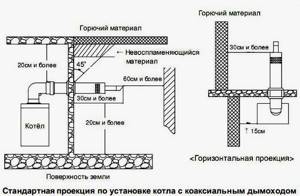
Requirements for the room where the gas boiler is located
Depending on the power and type of combustion chamber, room standards for installing a gas boiler may differ.
Room standards for a unit with an open combustion chamber
As already mentioned, a gas boiler with an open firebox must be located in a separate room, which is furnished and equipped in accordance with all standards. The boiler room must meet the following requirements:
- A room for installing the unit can be allocated on any floor of a private house, in the basement or attic. It is prohibited to install such a unit in a bathroom or toilet.
- If the power of the gas boiler does not exceed 30 kW, then the volume of the boiler room must be at least 7.5 m³. If the device’s performance is from 31 to 60 kW, then the required size is from 13.5 m³. With power from 61 to 200 kW – 15 m³.
- Ceiling height – 2-2.5 m.
- The width of the doors is not less than 0.8 m.
- The door to the boiler room should not be hermetically closed. It is necessary to leave a gap of 2.5 cm between the door leaf and the floor.
- An opening window with an area of at least 0.3×0.3 m², equipped with a window, should be provided. It provides sufficient illumination of the boiler room.
- Have a ventilation duct.
- Electrical switches located outside the boiler room.

Room standards for a boiler with a closed firebox
Technical standards for installing a gas boiler with a closed combustion chamber are not so strict. In this device, flue gases are removed from a closed firebox into a coaxial chimney, and a forced air flow is also provided through the same pipe. Therefore, gas boilers with a closed combustion chamber with a power of up to 60 kW are allowed to be installed in any non-residential premises that meet the following requirements:
- ceiling height more than 2 m;
- volume - at least 8 m²;
- well ventilated;
- The surface of the walls is made of fireproof materials.
It is even allowed to build turbocharged units into kitchen furniture.
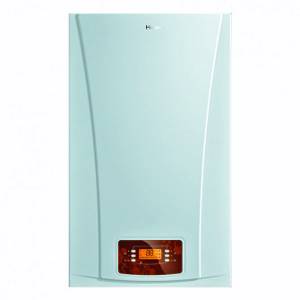
Read here - the stages of the first start-up of a gas boiler
How to install
In addition to the procedure described above, it is also necessary to take into account the requirements for the room where the equipment is installed and the rules for installing the boiler itself.
Premises requirements
If we talk about installing a gas wall-mounted boiler, the best place is the kitchen. Its layout is such that it meets the standards for placing gas equipment. In addition, gas and water have already been supplied there, so most of the problems have been solved. Here are the specific requirements for premises where household gas equipment is located:
- With a ceiling height of at least 250 cm, the area of the room should be greater than 4 m2.
- Be sure to have a window facing the street. Its area is at least 0.3 m2 per 10 m3 of volume. For example, a room is 3*3 meters, ceiling height is 2.5 m. Volume is 2.5*3*3=22.5 m3. The window area must be at least 22.5/10*0.3=0.675 m2. A standard window 1.2*0.8 cm has an area of 0.96 m2. That is, a window of this size is suitable, but with one condition - it must have a window or transom.
- The entrance door cannot be less than 80 cm wide.
- There must be ventilation holes located under the ceiling.
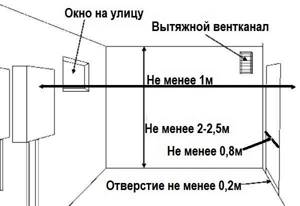
Requirements for the premises and placement of a gas boiler
Boiler installation requirements
In the accompanying documents for the boiler, each manufacturer lists its requirements. They do not go against the standards, only sometimes they can be tougher (softer - no). If you want the manufacturer's warranty to be valid, you will have to install the boiler in full accordance with the recommendations.
Here is what is required when installing each boiler:
- A wall-mounted gas boiler must be separated from the wall by non-flammable material. If the walls are tiled, that's enough. The presence of a layer of plaster is also considered sufficient. You absolutely cannot hang it directly on a wooden wall - no one will accept such an installation from you.

Another option for placing a gas wall-mounted boiler - The floor-standing gas boiler is installed on a non-combustible base. If the floor is concrete and covered with ceramic tiles, no other base is needed. It is necessary to lay a sheet of heat insulation on a wooden floor, on top of which a sheet of metal must be secured. The size of the metal sheet must be at least 30 cm larger than the dimensions of the boiler.
Chimney requirements
When installing a gas boiler of any type, you cannot make the chimney narrower than the outlet pipe. If the unit has an open combustion chamber, then with a power of up to 30 kW the chimney cross-section is at least 140 mm; with a performance of 40 kW, the chimney must have a diameter of 160 mm. Boilers with a closed combustion chamber are equipped with coaxial chimneys of the cross-section recommended by the manufacturer of the equipment.
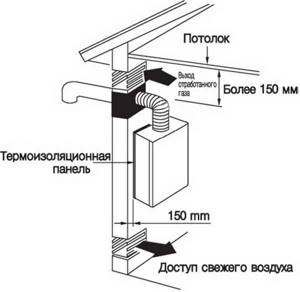
Connection and output to the wall of a coaxial chimney
Next, you should adhere to the rules: a pipe rises upward from the wall-mounted gas boiler to a distance of at least 50 cm, then there may be an elbow. There are no more than three bends along the entire length of the chimney. The combustion products of boilers with open combustion chambers are discharged into the existing chimney, with closed ones - either into the chimney, or through the wall to the street (do as indicated in the project).
Requirements for ventilation in the boiler room
In the boiler room or other room in which the gas boiler is located, it is necessary to provide forced and natural ventilation. Air replacement indicators are calculated based on the power of the unit.
Natural ventilation prevents the accumulation of carbon monoxide, which can be dangerous to the health and life of residents. Natural air flow is provided by windows, vents and doors.
Gas boilers with a closed combustion chamber do not require forced ventilation. It is provided by a coaxial chimney equipped with a fan, through which air is taken in from the street and smoke is removed.
In boiler rooms with an atmospheric unit, you will have to install supply and exhaust ventilation in the form of several fans that are connected to smoke detectors. When the concentration of carbon dioxide increases, the sensors give a signal and the fans start working.
Note! Good ventilation should ensure that the air in the room is replaced three times within 1 hour.
Fire safety standards
In order for a gas heating system to comply with fire safety standards, certain conditions must be met:
- Atmospheric devices can be located in the attic, basement or any other floor of the house. It is prohibited to place these units in the basement.
- Turbocharged gas boilers are allowed to be installed in any non-residential premises, as well as in the attic and basement.
- Doors to rooms containing gas appliances must open outward.
- The boiler room is finished with fireproof materials with a minimum fire resistance limit - no less than EI45.
- Turbocharged mounted gas boilers are fenced off from the adjoining wall with a shield made of non-flammable material. Floor-standing models are placed on a fire-resistant lining.
Flammable interior elements may be installed next to the boiler no closer than 30 cm.

Energy supply rules
The energy supply of a gas boiler includes the following conditions:
- Mandatory grounding of the unit - this eliminates the possibility that a spark of static electricity will cause a fire.
- It is recommended to connect volatile devices to a voltage stabilizer and an uninterruptible power supply. Otherwise, if the power goes out, the owners will be left not only without light, but also without heating.
- The socket for the gas boiler must be located close to it so that it is possible to connect the device directly. Carrying bags are not permitted.
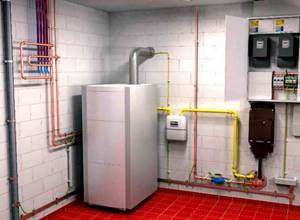
Requirements for the chimney device
The rules for installing a gas boiler in a private house are supplemented by the rules for installing a chimney if the unit has an open combustion chamber. The following requirements apply to the chimney installation:
- The pipe cannot have more than 3 turns.
- The section connecting the boiler pipe and the chimney has a length of no more than 25 cm.
- The diameter of the pipe must correspond to the power of the unit.
- The edge of the chimney is placed at least 50 cm above the ridge of the roof.
- The hole for the pipe to pass through the ceiling is made larger than the diameter of the chimney. Fire-resistant material is placed between it and the ceiling material.
- To ensure the collection of condensate and soot during cleaning, a condensate collector should be provided at the bottom of the pipe.
When installing a gas boiler with your own hands, it is important to comply with all the requirements for the placement of a specific model of the unit. Otherwise, the gas supply company will not give permission to operate incorrectly installed equipment.
Sep 10, 2019adminlawsexp
vote
Article rating



